How to make a functional screen under a bathtub with shelves
No matter how newfangled and modern the bathroom design is, the unaesthetic appearance of the sides of the bowl and the legs mounted on pads can ruin all efforts.A functional screen under the bathroom will help not only to disguise unsightly communications, but also to compactly place the little things you need in the household.
If you are renovating your bathroom and are thinking about how to refine the bowl, our material will help you solve this difficult issue. Next, we will talk about what design options there are and how to make them yourself, without resorting to the services of specialists.
The content of the article:
Design features of screens
A bath screen is an indispensable interior element for bathrooms that are not very spacious. After all, they make it possible to use space more rationally.
Opening cavities can be horizontal or vertical.
They are easy to place:
- household chemicals (gels and powders, fresheners and rinses);
- little things (sponges and cotton napkins for cleaning).
The packaging of most chemical products is quite bulky. Due to the fact that the bowl body has a concave shape, the free space between the walls can be filled with a drawer or spacious shelves.They can easily accommodate boxes and bags of household chemicals of any size.
It will be easy to hide all communications behind the walls of the structure, protecting them from mechanical damage. Moreover, the installation of such a “screen” will not interfere with access to the pipes.
If necessary, it will be easy to remove.
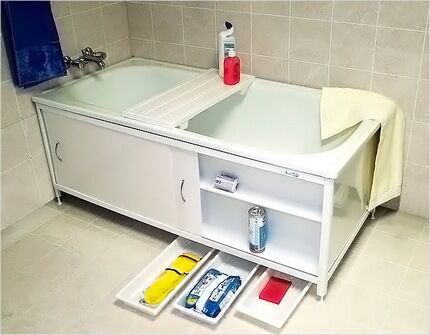
Beautifully designed bath screen will be an excellent addition to any interior, giving it a touch of extravagance and unusualness.
Thanks to the variety of finishing materials, giving free rein to your imagination, you can create an incredible design that will delight and at the same time surprise every time.

If it is not possible to make a sealed screen that does not allow water to pass into the space limited by the walls of the screen, it is necessary to ensure its ventilation. Everything hidden behind the external camouflage must dry out and the condensation must evaporate.
Popular options
Modern screens are not just a blank wall covering the legs of a bowl and the communications laid between them. Almost all structures are equipped with at least one door for storing things and accessing communications.
The choice of design depends on the size of the room, taste preferences and financial capabilities of the owner.
Solid, tightly closing
Solid screens, which are blank walls, cover all excess space, hiding the system of water and sewer pipes from view.
For this reason, when installing closed blind screens, you need to be sure that the pipe routing is in perfect order. Solid walls should be installed only if plastic pipes that are not subject to corrosion are used.
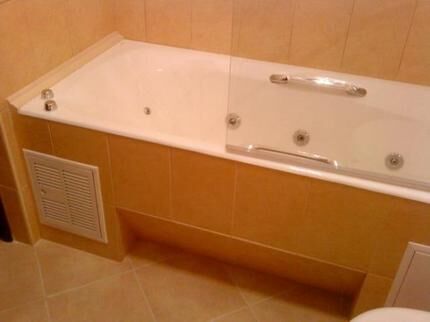
Designs with hinged doors
Screens with hinged doors are chosen for spacious bathrooms. After all, opening the doors 90° requires additional free space.
Depending on the dimensions of the bathroom bowl, the screen can be equipped with one or two ergonomic hinged doors.
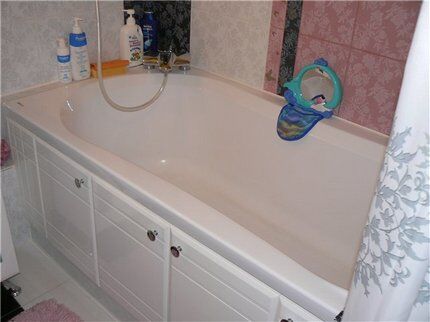
Sliding door systems
Screens with sliding doors often chosen by owners of small bathrooms. After all, opening the system does not require additional space. A convenient sliding system allows access to the farthest corners under the bottom of the bathtub.
Thanks to the guides, the doors can easily move within the system, providing a compartment-type sliding effect. The only thing is that if dust and small objects get clogged in the grooves, moving the doors becomes difficult.
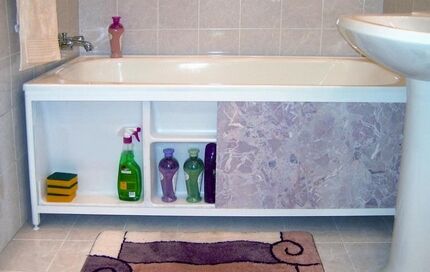
Frame and sashes material
The basis for making a screen for a bathtub with doors or shelves can be any material: plastic and MDF, metal and ceramic tile, glass and mirrors...The main requirement is that all materials used in the bathroom are not afraid of moisture and temperature fluctuations. In addition, they should not be susceptible to rapid destruction from mold or mildew.
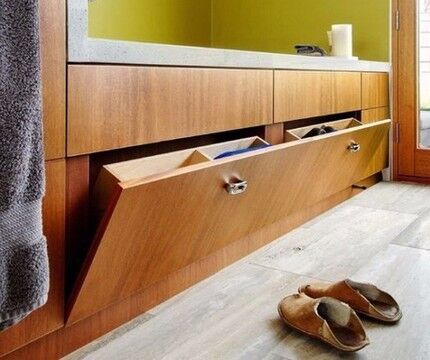
But if you are a supporter of natural surfaces and plan to make the screen doors from the same wood, keep in mind that you will have to take care that less moisture gets on the panels. In addition, you will need to regularly ventilate the room.
While some materials already have attractive properties in themselves, others require further finishing. For example, in order for drywall to fit organically into the design of a bathroom, it is covered with tiled mosaics.
The easiest way to build a presentable and functional screen is to use plastic panels.

To remove dirt and deposits, you just need to wipe the surface with a damp cloth.
Don’t like to spend a long time searching for the necessary items and things? Install plexiglass panels. Organic glass, unlike its “ordinary” counterpart, is lighter and stronger, which is why it is widely used as a basis in the manufacture of interior items.
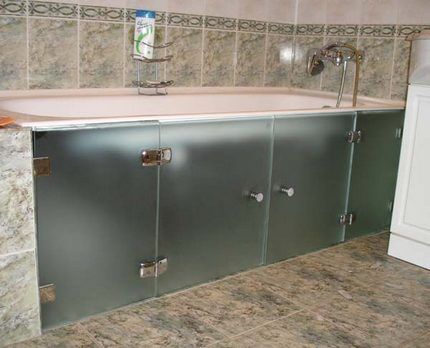
Do you prefer a non-standard way to define the space under the bathroom? An excellent solution in this case would be a fabric partition made of nylon fabric. Covering the panels is not difficult to do yourself.
Design in the form of a plasterboard box
For construction screen in the bathroom Moisture-resistant drywall is ideal, attractive due to its ease of use and affordable cost. The manufacturer of a functional structure in the form of a box does not need special skills, and in addition, you can always purchase the materials necessary for installation at the construction market.
The surface of a plasterboard box can be finished with mosaics, covered with plastic or ceramic tiles, covered with any type of lining or other facing material.
Making a screen for a bathtub with shelves
Making and installing a screen under a bathtub is not that difficult. If everything is done correctly, such a multifunctional design will serve you well for many years.
Stage No. 1 - preparing the necessary materials
The wooden frame is made of timber with a section of 40x40 mm or a reinforced metal profile PN 27*28.
The standard parameters of a sliding screen are: length 148 or 168 cm, height, depending on the model, varies between 57-65 cm.
To carry out the work you need to prepare:
- carpentry tool set;
- building level;
- perforator;
- Bulgarian;
- sealant;
- polyurethane foam;
- "liquid Nails";
- construction knife;
- self-tapping screws and self-tapping screws.
When choosing the size of the screws, be guided by the thickness of the frame profile in order to prevent damage to the bowl during the installation process.

When planning to build a wooden frame, the wood blanks should be coated with 2-3 layers of special impregnation before installation. The primer will have a double effect: it will prevent the proliferation of microorganisms and protect the wood from moisture. In addition to wood, you can build a frame from other materials.
If you want to build a screen from plasterboard, use moisture-resistant sheets for the work. In places where there is likely to be contact with water, they must be additionally treated with a water-repellent primer or puttied.
Stage No. 2 - construction of the structure frame
The main mistake that some craftsmen make is that they make an error when determining the dimensions of the structure relative to the plumbing, and also do not take into account the material of the bathtub bowl when constructing the support.
Thus, an incorrectly calculated frame support can even lift a lightweight steel and acrylic bowl. As a result, the first time you try to draw water under the force of gravity, the structure simply deforms.
The construction of the frame is carried out in the following sequence:
- Markings are applied around the perimeter of the bath.
- Along the marked lines, the starting profile is fixed to the floor covering using dowels.
- Vertical profiles are mounted, maintaining an equidistant distance of 60 cm.
- An additional stand is made in the side supports and places where they plan to place a drawer or arrange a shelf.
The projection of the frame onto the floor is carried out using a plumb line.

When drawing a line for installing the frame, keep in mind that the finishing also has a certain thickness.So, when planning to cover the screen with ceramic tiles, it is necessary to “sink” the frame to the depth of the finishing layer.
It is much more convenient to wash the bathtub bowl or wash clothes in it if there is a recess for the feet on the outside. To provide a recess for the legs, the frame can be recessed under the front edge of the bowl by 10-15 cm. The width of such a recess should be about 30-35 cm.
The starting profile laid along the line is screwed onto self-tapping screws, fixing it both to the floor and to the adjacent walls. Approximately at the middle of the height of the side posts, horizontal jumpers are attached. They will add rigidity to the structure.

To create a tight joint with the floor and prevent the penetration of moisture, the lower edge of the laid profile is sealed with sealant. In order not to damage the bowl with aggressive fastenings, it is advisable to blow out the top profile with polyurethane foam.
If you plan to install sliding doors, a guide profile is mounted along the top and bottom sides of the frame. Its length must strictly correspond to the width of the opening. The profile is fixed in such a way that there is no gap between the side wall and the rail.
Stage No. 3 - production of functional shelves
Built-in shelves can be built from chipboard panels left over from disassembled cabinets, the same plasterboard sheets or plywood.
A sketch or drawing will help determine their location and calculate the dimensions.
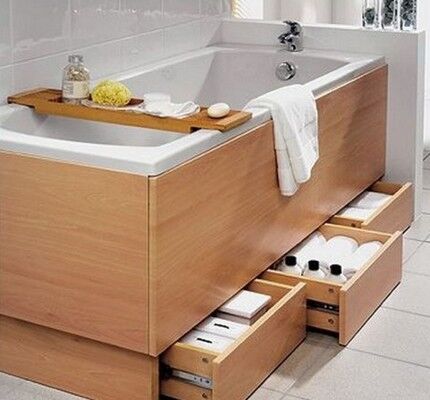
The width of the side shelves should correspond to the size of the niche formed between the wall of the room and the outer surface of the bottom of the bowl, minus the thickness of the limiting sections. When calculating, it is necessary to take into account the width of the metal frame profiles, which is at least 50 mm with a depth of 27 mm.
The dimensions of the frame and filling of the structure are determined by the dimensions of the niche. But the smoother the walls of the opening, the easier it is to equip a built-in wardrobe.
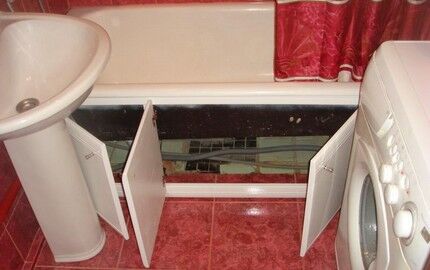
Along the front wall from the floor to the side of the bowl, you can place a row of low modules of one or two shelves. When determining the number of shelves, make sure that the distance between them is sufficient to accommodate tall containers and bottles.
Having cut out the necessary fragments from the chipboards, they begin to assemble the structure. The cabinet shelves are connected in an open way. To do this, the top and bottom panels are fixed to the sidewalls with self-tapping screws. Before drilling holes for screws, it is advisable to perform preliminary markings.

There can be any option for installing shelves. They can be attached to furniture corners, placed on dowels, or made removable by placing them on support rails. The back side of the structure can be left open, or it can be cut out of a thin sheet of MDF or plywood.
Stage No. 4 - installation of a drawer
The width of the drawer should be a couple of centimeters narrower than the internal width of the limiting sections.Otherwise, the retractable structure simply will not fit into the housing.
To make a drawer, you will need guides. Their length is chosen based on the thickness of the walls of the box.
There are two types of systems on sale:
- samboxes – simple roller guides;
- tandemboxes – improved systems with self-closer.
The simplest design option for a drawer is when the side walls are inserted between the front and back. Thanks to this solution, you can make the fittings invisible, and in addition there is no need to process the ends.
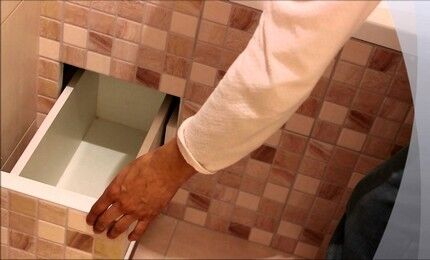
The dimensions of the bottom should be 1-2 mm smaller than the dimensions of the box box. This assembled structure will have no protruding ends.
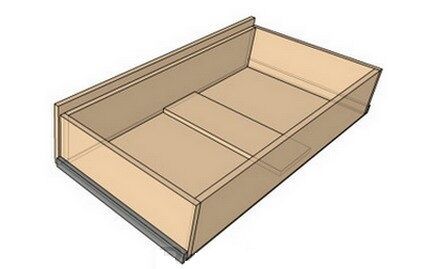
The bottom of the box, most often made of fiberboard, is filled with 20 mm nails and “reinforced” with 16x4 mm self-tapping screws. When connecting parts, it is important to make sure that the diagonals are the same.
The roller system is installed on the bottom edge: first thin on the box itself, and then thick on the limiting sections.
Having installed and secured the guides, the system is placed in its intended place.
Stage No. 5 - installation of closing sashes
The doors are done last. They are cut from MDF sheets according to the dimensions of the body. When planning to install hinged doors, you must purchase two hinges in advance for the top and bottom.
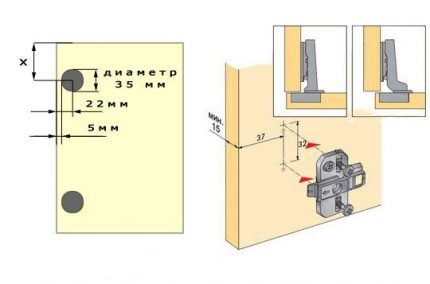
Having installed the “cup” of the hinge, screw in the screws. To attach the sash to the structure itself, the door is installed so that it does not extend beyond the edges of the hole made under it. Using the adjusting screws, the correct position is adjusted.
When installing hinged sashes, it is necessary to ensure that the edges of the sashes and the ends of the wall coincide. The gaps should be the same along the entire contour.
Some models use magnets to secure the doors. The master’s task is to unscrew the shutter screw and adjust the position of the door so that the magnets coincide.
Screen panel cladding
The cutting of facing plastic or MDF panels is carried out using a grinder or a construction knife. The blanks are cut in accordance with the height of the screen. Plastic panels are attached to the frame bars using “liquid nails”.

When gluing sections of panels to the top profile, do not forget to leave enough space for the subsequent installation of the plastic plinth. It is fixed with self-tapping screws designed for working with metal products, or it is glued with “liquid nails”. The glue is applied by slightly moving the wall back, and then pushing it into place.
To improve the joints, a plastic plinth is also placed under the planks adjacent to the walls.
When working with plasterboard sheets, the height of the blanks is made a couple of centimeters shorter. They are secured by retreating one centimeter from the floor and the upper edge of the bowl.
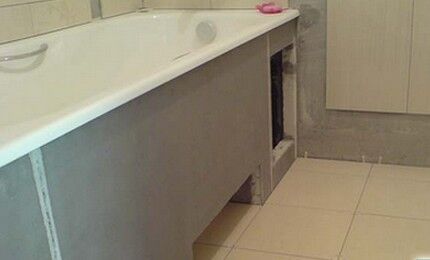
The blanks are fixed to the frame, “planting” them on screws every 15-20 cm.
The screen surface is assembled from cut panel blanks. A hole is cut in the place where the technological hole is provided.
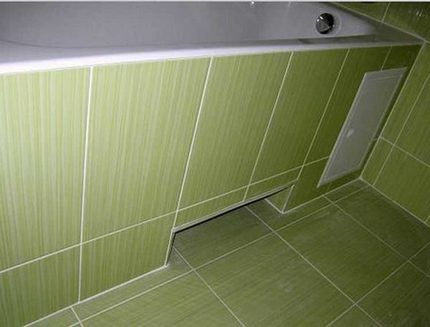
Available for sale plumbing hatches made from moisture-resistant gypsum fiber sheet or aluminum. They are many times stronger than their plastic counterparts, and therefore can last many times longer.
A worthy alternative to stationary structures are removable panels, which are conveniently attached to the front wall of the screen using magnets.
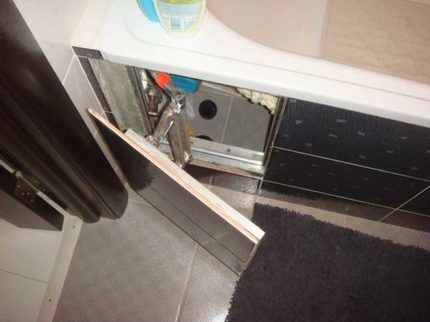
Subsequently, it can be decorated with a lattice, lined with artificial stone or mirrors. Thanks to this, the hatch will blend harmoniously with the wall, becoming invisible.
Conclusions and useful video on the topic
Making a screen for a bathtub with a niche for feet:
How to assemble a drawer:
A bath screen with shelves is a practical solution. In terms of spaciousness, it is in no way inferior to built-in cabinets, but at the same time it does not take up any space in the bathroom.
Do you have any questions, have you found any inaccuracies, or do you have valuable information that will help supplement our material? Please leave your suggestions and ask questions in the block located at the bottom of the article.
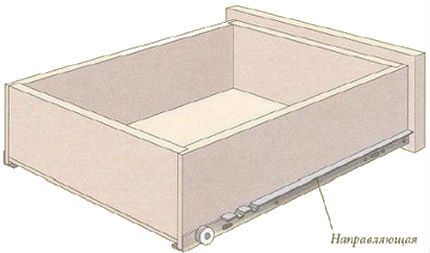




I myself faced the same problem at my dacha; I needed to make small places to store household chemicals under the bathroom. I didn’t think twice about it - I just laid the tiles in the center on a plasterboard base, and made small doors on the sides. I think it turned out pretty well for a dacha, but something better could have been invented and built. In general, the main thing is to start, since you can always redo it)
Can I install solid structures that close tightly if I do not have plastic pipes, but no traces of corrosion have been detected on them? And what material, other than plastic, is it best to make structures from? Please tell us in even more detail the pros and cons of drywall and plexiglass, which is more practical, what are the prices for these materials?
I categorically do not recommend installing bathroom screens in such a way that you will not have quick access to communications. In the event of a breakdown, which may occur, you will have to destroy the entire contraction.
If solid structures provide access to communications, then install in this way. Also remember that ventilation holes may be needed. They are needed to ensure normal air circulation in the box, which is formed after installing the screen. If there is no normal air circulation, fungus or mold may develop.
Regarding materials. In this regard, drywall is the best option in terms of price/quality. The only thing that may be required is waterproofing of this material. For example, using a special waterproof coating Ceresit CP 30 Aquablock.
If you use plexiglass, then such a design will cost a pretty penny, but from a design point of view it will look much better.
Hello. As for GKLV, its advantages are not only in cost. Drywall can be bent and created into almost any design. In particular, it makes a wonderful screen with niche shelves that can be made in any configuration, be it original triangles or classic squares/rectangles.
Another screen made of gypsum board can be covered with tiles/mosaics, painted in almost any color, and an inexpensive false panel can be glued onto it, such as those used on kitchen backsplashes with a theme, ornament, and so on.
Yes, the insulation will need to be taken care of, but overall it is a great material. I have a clever decorative fireplace made from it in my bathroom. On both sides of it there are functional shelves, and in the fireplace itself there are romantic candle lamps.
When constructing a screen, it is necessary to provide access to communications. The screen creates a closed space with high humidity. This means there is a high probability of corrosion development.
Is it possible to install a blind screen from an acrylic bathtub under a steel bathtub?
Good evening! Tell me, who can make a custom-made screen for a bathroom with stripes?